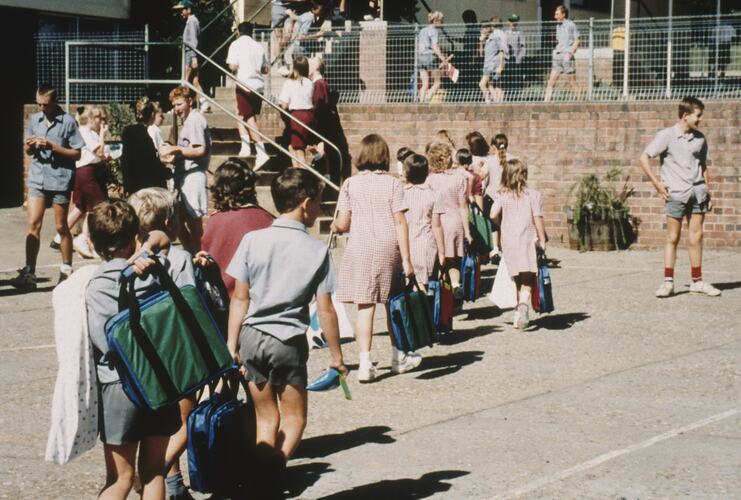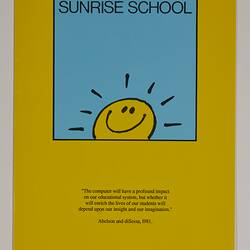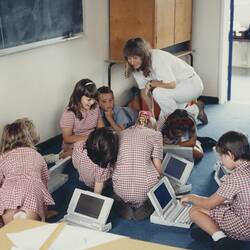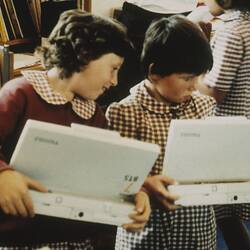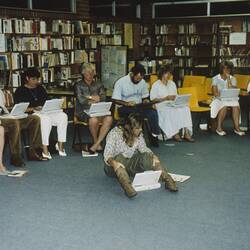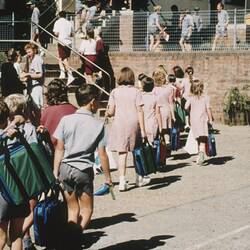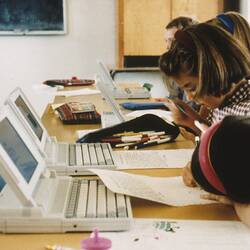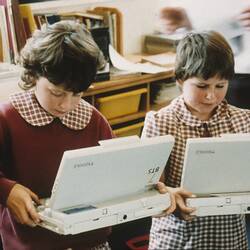These Sunrise Centres aimed to explore how computers and other digital technologies could facilitate changes to teaching and learning. The Sunrise Centres extended the groundbreaking work of the Sunrise School, a research and development project initiated by the Australian Council for Educational Research (ACER) and located at the Museum of Victoria (now Museums Victoria) between 1988 and 1989. The establishment of the Sunrise Centres expanded the exploratory work conducted in the informal setting of the museum into both public and private school settings. They also generated some important research outcomes, informed developments in Australian educational computing policy, and led to the development of the world's first laptop classes.
MLC Sunrise Centre
After attending the launch of the Sunrise School in 1988, David Loader, Principal of the Melbourne private girls' school MLC contracted ACER to establish a Sunrise Centre at his school to begin operating in 1989. In its first year, one Year 7 class was selected to participate in the Sunrise program in which computers would be integrated across the curriculum and students would be encouraged and supported in undertaking self-directed project-based learning in accordance with the types of practice that had emerged from the Sunrise School. In 1990, following the success of the first MLC 'Sunrise' class, the program was expanded to include more classes. In this year, the program was also extended through the creation of 'laptop classes' where each student in Grade 5 had their own personal laptop to use at school and home. Notably, the distinction of these classes was not just that every student had a laptop, but that the classroom context in which they would be using them was free to be reformed by their teachers to better facilitate new types of learning.
The MLC laptop classes were a world first! The school subsequently committed to becoming a laptop school. By 1994, all students in Grade 5 and above had a laptop and MLC had established an international reputation as a leader in educational computing. The school attracted a steady stream of observers from across Australia and the world.
Queensland Sunrise Centre (Coombabah)
In 1989, the Queensland Department of Education began working with ACER to set up a Sunrise Centre in the State. The Department and ACER selected Coombabah State Primary School, a public co-educational primary school located in a suburb in the Gold Coast, as the site for the Sunrise Centre. The Sunrise program at the school began in 1990 and the plan was for it to operate for four years. In the first year a class of 60 students in Grade 6 and their two teachers were key participants. Half of the students had access to personal laptops while the remainder shared one computer between two. The technology-rich learning environment of the classroom was completed with the addition of a range of digital peripherals including a printer, scanner and CD-Rom devices. In the second year (1991) an additional 60 students were added to the program and all students had personal laptop computers for use at school and home.
The Queensland Sunrise Centre generated a number of important research outputs including a report into the first year of the implementation of the program funded by the Queensland Department of Education, a substantial report into the impact of educational computing at the site by Dr Helga Rowe and ACER and a doctoral thesis that evaluated the full duration of the project.
Batlow Sunrise Centre
A third Sunrise Centre was established in 1992 at the Batlow Technology School in the small New South Wales town of Batlow. In 1990, the NSW Minister for Education announced that Batlow Central School would be renamed and become a technology school. This prompted the school to begin examining ways in which it could adapt its curriculum and teaching strategies to reflect its new status. As part of that process the school contacted Liddy Nevile, then the Director of the Sunrise Laboratory at RMIT and initiated the development of a local Sunrise Centre. The Batlow Sunrise Centre program engaged a class of Year 3 students. Each were given access to laptop computer and Logo programming software designed for use by children. The class teacher was provided training and support in designing Sunrise-style classroom activities. In 1993, Charles Sturt University published an evaluation of the program which recognised it as a successful innovation.
References
Braggert, E.J. (1993) Laptop Use at Batlow Technology School. Charles Sturt University.
Finger, G.D. (1995). Evaluating the integration of learning technology in Queensland state schools: A case study of the Queensland Sunrise Centre. Australian Council for Educational Research.
Johnstone, B. (2003) Never Mind the Laptops: Kids, Computers, and the Transformation of Learning, iUniverse, Lincoln.
Rowe, H.A., Brown, I, & Lesman, I (1992) Learning with personal computers: issues, observations and perspectives. Australian Council for Educational Research.
Ryan, M., Betts, J., Grimmett, G., Hallett, K., & Mitchell, D. (1991) The Queensland Sunrise Centre: a report of the first year. Australian Council for Educational Research.
More Information
-
Keywords
-
Authors
-
Article types
